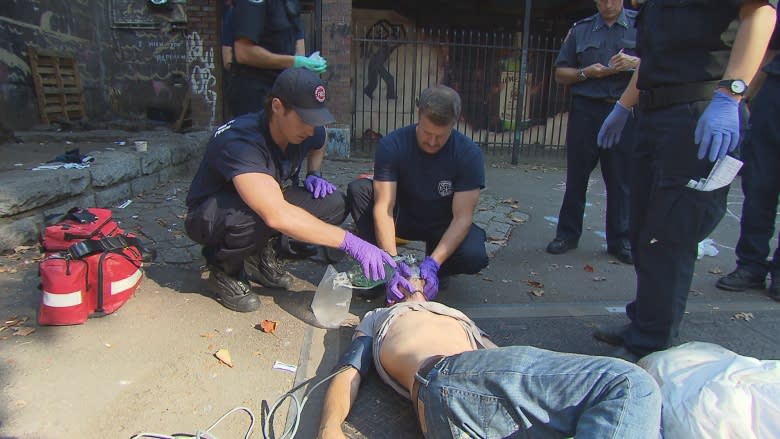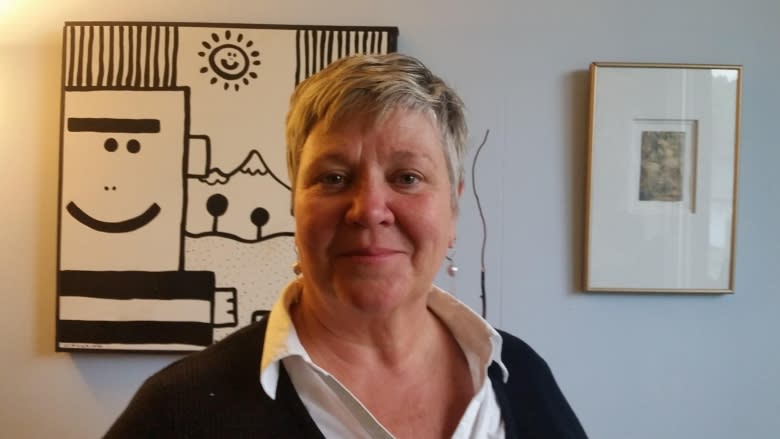Deadly fentanyl crisis missing from campaign trail in B.C.
The offices of the Watari Counselling and Support Services Society are on the second floor of one of the many nondescript buildings that line Vancouver's East Hastings Street.
The enticing aroma of cooking permeates the hallways. A counsellor is busy setting up for an art therapy class in one room; items of food are being laid out in another. Closed doors along the hall indicate one-on-one counselling is already underway despite the early hour.
Watari is Japanese for a small bridge. And that's what the charity's executive director, Michelle Fortin, says they offer to young people and others who are hooked on fentanyl — a bridge out of Vancouver's Downtown Eastside, a bridge to a life that's no longer controlled by the insatiable desire for the synthetic opioid that's led to hundreds of fatal overdoses in B.C., and which continues to claim new victims every single day.
"We have a lot of people who are in a lot of pain," Fortin says. "We need to approach things from across the spectrum. Not just when they're drowning. We have to find out why they got into the water in the first place."
'Has to be part of your platform'
The province declared a public health emergency a year ago because of all the overdoses — there were 931 deadly overdoses in 2016 alone. But Fortin says the opioid crisis isn't getting the attention it needs from campaigning political leaders with less than a week to go before British Columbians vote.
"They're discussing it when they're asked about it," she says in an interview with CBC Radio's The House that airs Saturday. "I think when you've got a crisis like this it has to be part of your platform. It shouldn't just be something you're reacting to. There should be a response that has been well thought out."
Fortin's not alone. Vancouver Mayor Gregor Robertson says the critical shortage of affordable housing in the city, the number of people living in poverty and the challenges posed by opioids just aren't being addressed.
"They aren't getting as much attention on the front lines of the election as they should be," he says. "The province is doing well economically. Certainly Metro Vancouver is booming … For a lot of us it doesn't sit well that we can be economically successful yet we have such vulnerabilities."
Fentanyl addiction isn't just a problem on the bleak sidewalks and alleyways of Vancouver's Downtown Eastside. It's an equal opportunity killer, blind to race, age or social status.
It's reached the bedroom communities outside Vancouver and spread to the province's interior where privately run, unregulated treatment programs are often the only option.
Linked by loss
Michelle Jansen lost her son, Brandon, to a fentanyl overdose when the drug was smuggled into the treatment centre where he was staying back in March 2016. He was 20 years old.
She's part of a group of mothers who sent an open letter to the three party leaders last month, arguing more resources are needed to respond to the opioid crisis.
"There are no good options to receive treatment," Jansen says in the dining room of her home in Coquitlam, a 40-minute drive east of Vancouver.
Jennifer Woodside and Deb Bailey are also at the table. They're all from different towns in the Lower Mainland, but they're each linked by the loss of a child to a fentanyl overdose.
"You know, what really makes me angry is that there is such a stigma, that people think people want to be addicted to a substance," says Woodside, as Jansen nods in agreement.
The leaders replied to their letter, but the women say all three fell short of the kind of specific financial commitment they believe is needed, including a pledge to earmark the taxes raised from legal pot sales in the future for opioid prevention and enough regulated treatment centres to address the massive scope of the problem.
"It is a stigma issue," Jansen repeats. "For our political leaders, to support the necessary funding and the resources, they aren't willing to jeopardize their political platform. It's disgusting."
B.C. Liberal Leader Christy Clark insisted during a televised leaders' debate on April 26 that the government is spending $100 million on support programs. NDP Leader John Horgan says his party is committed to appointing a minister of mental health and addictions whose sole job would be to address the opioid crisis using existing funding.
Back at Watari, Fortin says front-line workers in the Downtown Eastside aren't seeing much evidence of the spending, other than an increase in the supply of naloxone — the drug used to reverse the effects of an opioid overdose.
"We keep hearing that there's $100 million being thrown at the issue, specifically related to the opioid crisis. Other than naloxone kits, we're really not seeing work on the ground for folks that are struggling."
Fortin needs just three words to describe what will happen without that money, and without a concerted effort led by whatever party forms the next government on May 9.
"More people die," she says. "More people die."



